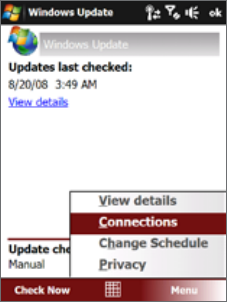
138 Managing Your Device
Tap Connections to change how the device connects to
the Internet when checking for updates.
Tap
Change Schedule to change how Windows Update
checks for Windows Mobile® updates.
•
•
13.10 Battery Saving Tips
How long your battery power lasts depends on the battery type and how you use your device. Try the
following to help conserve battery life:
When the device is not in use, press POWER to switch off the display.
Tap
Start > Settings > System > Power > Advanced tab. Here, you can specify the time before your
device automatically turns off the display and backlight to conserve battery power. For optimum
conservation, specify 3 minutes or less.
Tap
Start > Settings > System > Power > Backlight tab to adjust the backlight brightness settings.
Use the AC adapter to plug your device into an external power outlet whenever possible, especially
when using a storage card or when using a modem or other peripherals.
Turn Bluetooth off when you are not using it. Make your device visible to other devices only when you
are trying to establish a Bluetooth partnership. For more information about Bluetooth, see Chapter 9.
Lower the volume.
Close battery-intensive programs, such as the Camera, when you are done using them. Make sure
the programs are ended and are not continuously running in the background. Refer to “Using Task
Manager” in this chapter for information on closing programs.
When you know you are out of range of your Wi-Fi networks, turn Wi-Fi off. Searching for networks
consumes a lot of power. For more information about Wi-Fi, see Chapter 11.
Tap
Start > Settings > Connections tab > Wi-Fi and then tap Menu > Advanced. From the Turn off
Wi-Fi if not connected in list, select a timeout period so that Wi-Fi can be automatically turned off
when your device is not connected to any wireless network for some time.
•
•
•
•
•
•
•
•
•
